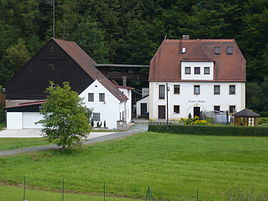Friedrichsthal (Bayreuth)
|
Friedrichsthal (Bayreuth)
municipality Bayreuth
Coordinates: 49 ° 57 ′ 28 " N , 11 ° 37 ′ 2" E
|
|
|---|---|
| Height : | 354 m |
| Incorporation : | 1972 |
|
Powder mill in the valley of the (warm) Steinach
|
|
Friedrichsthal is a district of the city of Bayreuth .
location
The village is located, partly on a hillside on the "Kalten Leite", at the exit of the (warm) Steinach valley between the Oschenberg and the Rodersberg . To the east lie the villages Höflas and Döhlau, which belong to Weidenberg , in the valley , to the west Friedrichsthal borders the Bayreuth district of Laineck . The Döhlauer Graben canal, which fed the Brandenburg pond at the time of Margrave Georg Wilhelm , ran through the village on the slope . From Döhlau it has been preserved up to a small power station at the level of the former flax spinning mill.
history
In 1757 a hammer mill for a brass wire factory was built on the Steinach. Nine years later it was converted into a “Poudre mill” for the production of powder for wigs at the Bayreuth court , owned by court agent Isaac David Seckel. Today it is used as a residential building.
In 1791, the Bayreuth innkeeper Johann Friedrich Schnaufer von Seckel acquired some land and a building, which he demolished and rebuilt as a restaurant at the foot of the Kalten Leite. The place name, which first appeared in the church records of Sankt Johannis two decades later, is probably due to his middle name.
In 1846 the first Bavarian flax spinning mill was built in Friedrichsthal. Workers from the surrounding areas commuted there, e.g. B. Leineweber from nearby Sankt Johannis. The machines were operated by means of transmission belts with water power from the Döhlauer Graben. In the spring of 1928, the company was shut down and in 1929 sold to the mechanical cotton spinning mill in Bayreuth , which set up a cotton weaving mill in the buildings . This company existed until 1981. On April 14, 1988, the factory, which was only used as a warehouse, was largely destroyed in a major fire, but the administration building was retained.
When the railway to Warmensteinach was built , Friedrichsthal was given a train station that is still in operation, as well as a loading platform. The Friedrichsthal restaurant, which had changed owners and tenants several times, experienced a strong upswing thanks to the railway. On Sundays, citizens of Bayreuth came to the beer garden by train, which reached Friedrichsthal in 17 minutes from the main train station . In June 1898, on the occasion of the flag consecration of the Concordia Laineck choral society , there was even evidence of the use of special trains.
The rifle guild was founded in 1911, and in 1925 it was given a shooting range on the premises of the innkeeper. In the 1950s, the inn was expanded into a guesthouse , and prominent employees of the Bayreuth Festival such as Wilhelm Furtwängler and René Kollo were also guests. The opera director Patrice Chéreau celebrated the conclusion of his performances of the Ring des Nibelungen there in 1980 . In 2005 the traditional excursion restaurant was given up and then demolished. A residential building in the form of a terrace was built on the site.
Together with Laineck, the place was incorporated into Bayreuth on July 1, 1972.
Current situation
Friedrichsthal cannot be clearly separated from the Laineck district of Oberend. This is where the Friedrichsthal street begins, where the popular excursion restaurant of the same name was also located. The Friedrichsthal train station is also in Laineck-Oberend.
traffic
The main axis is the Warmensteinacher Straße, which lost its function as an arterial road into the Fichtelgebirge after the construction of the bypass road . The Friedrichsthal train station is served every hour by trains on the Bayreuth– Weidenberg line. The city buses on VGN line 301 run every 20 minutes with gaps of up to 38 minutes.
literature
- Herbert Popp: Bayreuth - rediscovered . Ellwanger, Bayreuth 2007, ISBN 978-3-925361-60-9 .








